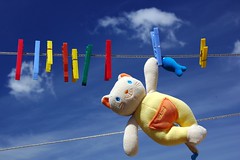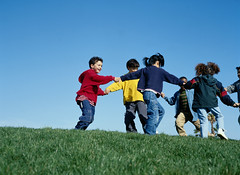-
If you are citizen of an European Union member nation, you may not use this service unless you are at least 16 years old.
-
You already know Dokkio is an AI-powered assistant to organize & manage your digital files & messages. Very soon, Dokkio will support Outlook as well as One Drive. Check it out today!
| |
Theoretical-Models-for-Play
Page history
last edited
by Gail Matthews-DeNatale 8 years, 3 months ago
Theoretical Models/Types of Play
Pages in this wiki:
Home, Play Theories, Designing for Play-Based Learning, Bib/Webography, Quotes
Raph Koster: A Theory of Fun for Game Design
 Fun is the act of mastering a problem mentally. It is the feedback that our brains give us when we are absorbing patterns for learning purposes. If a problem is too easy or too hard, it's not perceived as "fun." As a person's mastery increases, things that used to be "fun" may become boring (e.g. Tic Tac Toe). Fun is the act of mastering a problem mentally. It is the feedback that our brains give us when we are absorbing patterns for learning purposes. If a problem is too easy or too hard, it's not perceived as "fun." As a person's mastery increases, things that used to be "fun" may become boring (e.g. Tic Tac Toe).- Delight strikes us when we recognize patterns but are surprised by them. Unfortunately, delight doesn't last -- it's fleeting because the act of recognition is not an extended process.
- Fun is contextual. The reason why we are engaging in an activity matter. This is why a given activity may be fun when done voluntarily and a similar activity may not be fun when done in a school setting that awards grades.
- "Fun" games pose questions (logical, ethical, even ontological). The challenge for game designers is to create games for which even they don't have the complete answer. The challenge that we all face is to solve our own puzzles that don't have one right answer.
National Institute for Play: Types of Play
 Attunement Play: e.g., the parent-child bonding that takes place during peek-a-boo with an infant Attunement Play: e.g., the parent-child bonding that takes place during peek-a-boo with an infant- Body and Play Movement: fe.g., jumping, skipping, or twirling just for the sake of it
- Object Play: e.g., banging pans, skipping rocks, shooting marbles
- Social Play: This type has three subsets
- Belonging: charades or hide-and-go-seek
- Rough and Tumble: roughhousing, arm wrestling
- Celebratory: theme parks, birthday parties
- Imaginative and Pretend Play: e.g., imaginary friends, dress-up, make-believe
- Storytelling / Narrative Play: e.g., puppet shows, shaggy dog stories
- Transformative-Integrative Play: e.g., Einstein imaginatively riding pleasurably on a sunbeam at the speed of light, playing around with ideas for new products, play + science = transformation
Note: a play event may fall into more than one of these categories, particularly online or ARG play.
Scot Osterweil: The Four Freedoms of Play
Scot Osterweil (MIT Comparative Media Studies, Education Arcade Project) has observed this truth: play has no agenda. Freedom is central to the experience of play. To understand the anatomy of play, Scot has identified four components that he calls the "four freedoms of play." If these freedoms are not respected, the play experience is severely compromised or even ruined.
 Freedom to Experiment Freedom to Experiment
The player's motivations are entirely intrinsic and personal. The process is open-ended.
- Freedom to Fail
Losing is part of the process.
- Freedom to Try on Different Identities
Players aren't necessarily limited by their bodies or surrounding physical context.
- Freedom of Effort
As described in Peter and Iona Opie's classic ethnography of playground culture, children may scramble around in a game of tag, avoiding being caught for twenty minutes, and then suddenly stop and allow themselves to be tagged once they have reached a certain degree of effort or perhaps want to move on to another activity.
Brian Sutton-Smith: The Ambiguity of Play
Citing the work of anthropologist Victor Turner, Sutton-Smith claims that play is "liminal" in that it occupies a threshold between reality and unreality. Citing William Epson's Seven Types of Ambiguity, Sutton-Smith describes the dimensions of ambiguity involved in the experience of play:
 The Ambiguity of Reference The Ambiguity of Reference
Is that a pretend gun sound, or are you choking?.
- The Ambiguity of the Referent
Is that an object or a toy?
- The Ambiguity of Intent
Do you mean it, or is it pretend?
- The Ambiguity of Sense
Is it serious, or is it nonsense?
- The Ambiguity of Transition
You said you were only playing
- The Ambiguity of Contradiction
A man playing at being a woman
- The Ambiguity of Meaning
Is it play or playfighting?
The Strong National Museum of Play: Elements of Play

- Anticipation
- Interest, openness, readiness, expectation, curiosity, desire, exuberance, wonderment
- Surprise
- Appreciation, awakening, stimulation, excitement, discovery, arousal, thrill, astonishment
- Pleasure
- Satisfaction, buoyancy, gratification, joy, happiness, delight, glee, fun
- Understanding
- Tolerance, empathy, knowledge, skill, insight, mutuality, sensitivity, mastery
- Strength
- Stamina, vitality, devotion, ingenuity, wit, drive, passion, creativity
- Poise
- Dignity, grace, composure, ease, contentment, fulfillment, spontaneity, balance
Download a high-resolution version of the chart - Elements of Play050114.pdf
Theoretical-Models-for-Play
|
|
Tip: To turn text into a link, highlight the text, then click on a page or file from the list above.
|
|
|
|
|
Comments (0)
You don't have permission to comment on this page.